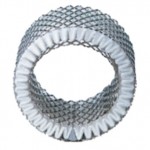Water is something most people take for granted. In the United States, it seemingly runs freely, but the process of purifying and filtering water is actually quite complex. The difficulty and expense of water filtration hinders many countries from providing clean water to their citizens, which leads to disease and lack of proper food sources. Water innovation is part natural science, part technology and part imagination. Water treatment, whether done in a large plant or through home systems, is an ever-growing field of study.
Contamination
Water contamination comes from many sources. Rain falls through polluted air and lands on soil full of chemicals. Contamination can be this simple. Water is also a magnet for bacteria and other microorganisms. Water collects in soil, so any foreign matter, heavy metals or decomposing material in that soil ends up in the water as well.
Water treatment processes do two things. First, they filter out particles and sediment. Treatments also neutralize chemicals and organisms in the water to make it safe to drink. Drinking untreated water can cause illness and even death. Not all water is for consumption, though. Treatment processes depends on the desired end-use of the liquid. Sources for industry use, for example, do not need to be as clean as the water that comes out of the faucet. Some treatments only reduce the concentration of contaminants.
Water treatment protocols
Current water treatments consist of one or more of the established technologies. Most water processing involves pre-chlorination, coagulation, sedimentation, filtration, desalination and disinfection. Each step works towards a specific goal. For example, pre-chlorination removes algae and other forms of biological growth from the water. The forward goal of water filtration technology is efficiency. Scientists and researchers are looking for ways to make water safe without expending tremendous amounts of energy and by improving methods of water reclamation.
Water reclamation
Water reclamation is a key area of study. This process treats wastewater, both commercial and residential, for reuse in some way. The need for water takes its toll on ecosystems like wetlands. Many species of wildlife depend on wetlands for survival. Society messes with the natural flow of water systems leading to the death of plant and animal life for that area. One of the goals of water reclamation is to return wastewater to these areas after treatment.
Water reclamation also reduces the pollution going to larger bodies, such as the oceans. Sewage and wastewater has to go somewhere. Unfortunately, in the past, dumping into large bodies of seawater was all too common. Many of the chemicals from irrigation and biological waste are harmful to the natural flora in the oceans. Water reclamation takes what was once waste and makes it useful again to reduce dumping.
Nanotechnology
One exciting area of water innovation is nanotechnology. Put simply, nanotechnology involves working with devices and materials that are very tiny, generally between 1 to 100 nanometers in length. Each year, millions of people die from waterborne illness and disease in developing countries. Water treatments for these areas must be practical. Poverty-stricken regions often do not have proper sanitation and sewage management. Water treatments must be point-of-use procedures to be effective. In other words, these areas need treatment processes that residents conduct themselves in order to offset some of the sanitation issues. Engineers working in the field of nanotechnology are concentrating on water filtration and treatment systems that might be effective in these impoverished areas. The research is in the early stages of development and is not without pitfalls, but it does look promising.
Water filtration for the home
Home water filtration is expanding as well. Filtration involves running the water through a filter to remove any impurities that might remain after the initial treatment. The process is done through the refrigerator, faucet or a stand-alone device such as a pitcher. These devices are cost effective and only require filter refills periodically. Some systems even filter via the main water line. This means all the water coming into the property is clean.
Just like any form of technology, home filtration is getting smarter. Major appliance research and development departments are looking to smart technology for future innovations. Smart systems monitor water usage and use sensors to adjust filtration standards based on data collection.
 Clean water is a growing need, so water technology is an expanding field. The need goes beyond the average home; water treatment, reclamation and filtration are global necessities. The answer to the world’s water problems probably lies in a combination of natural science and technology.
Clean water is a growing need, so water technology is an expanding field. The need goes beyond the average home; water treatment, reclamation and filtration are global necessities. The answer to the world’s water problems probably lies in a combination of natural science and technology.

